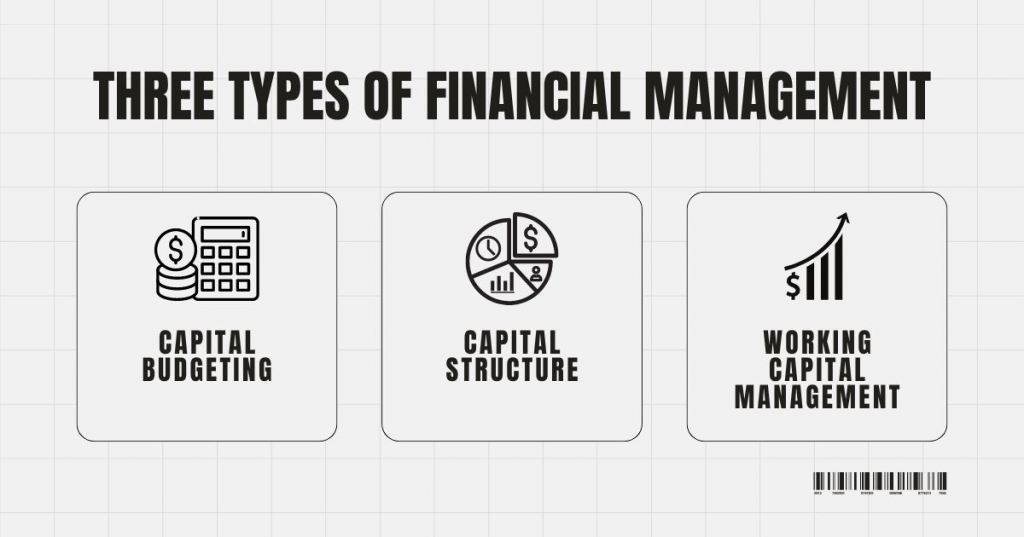Financial Management: Definition, Types, Functions & Example
Financial management is a cornerstone of any successful organization. It involves planning, organizing, controlling, and monitoring financial resources to maximize value and ensure stability. Understanding financial management is essential for businesses of all sizes, as it influences every aspect of an organization's operations and growth.
In this article, we will delve into the fundamental aspects of financial management, exploring its importance, core functions, and the three main types that define its scope. Additionally, we will illustrate these concepts with a practical example, providing a comprehensive overview of how financial management supports organizational success.
What is financial management?

Financial management is the process of planning, organizing, directing, and controlling financial activities within an organization or individual setting. Its primary goal is to manage the financial resources efficiently to achieve the organization's objectives and maximize value. This field includes a range of activities such as budgeting, forecasting, investment analysis, managing cash flow, and ensuring financial stability and growth.
Here's a breakdown of what financial management entails:
Individuals: Financial management involves budgeting, saving, investing, and making sound financial decisions to achieve personal financial goals like buying a house, saving for retirement, or paying down debt.
Organizations: Financial management is concerned with managing the company's finances to maximize profit, ensure financial stability, and make good investment decisions. It involves tasks like financial planning, capital budgeting, and risk management.
In general, financial management is about taking control of your money and using it strategically to reach your financial objectives.
Effective financial management is essential for the sustainability and growth of any organization. It ensures that financial resources are used efficiently, financial risks are managed, and financial goals are achieved.
Importance of financial management

Financial management is crucial for the sustainable development of both organizations and individuals. Here are key reasons highlighting its importance:
Efficient Resource Utilization
Financial management ensures that financial resources are used effectively. It involves planning and controlling financial activities to optimize resource allocation, minimize waste, and maximize value.
Financial management ensures that the most critical and high-return projects receive the necessary funding, supporting organizational priorities and growth.
Financial Stability and Growth
Financial management allows for the identification of potential financial issues and the development of strategies to address them.
Companies need to manage costs and optimize revenue. Financial management helps them in maximizing profits. It involves cost control measures, efficient pricing strategies, and identifying profitable investment opportunities.
Effective financial management helps you weather unexpected events and emergencies. An emergency fund can act as a buffer for job loss, medical bills, or other unforeseen circumstances. Financial stability brings peace of mind and allows you to focus on other aspects of your life.
Investor Confidence
Strong financial management practices enhance investor confidence. Transparent financial reporting and efficient management of financial resources reassure investors about the organization’s financial health and ability to generate returns.
In summary, financial management is fundamental to the effective operation of any organization. It provides the framework for decision-making, supports strategic planning, ensures regulatory compliance, and enhances overall financial health and performance.
Functions of Financial Management

Financial management translates financial objectives into actionable steps through a variety of functions. Here are some key functions that financial managers perform:
Planning and Forecasting
The scope of financial management is broad and integral to the overall success of an organization. It creates financial roadmaps, budgets, and projections to ensure the organization or individual has enough funds to meet short- and long-term goals.
Financial management plays a vital role in strategic planning. It involves setting long-term financial goals and developing strategies to achieve them, aligning financial planning with the organization’s overall strategic objectives.
Dividend Policy
For organizations, financial management includes determining how much profit to distribute to shareholders as dividends and how much to retain for reinvestment in the business. This decision impacts shareholder value and the organization’s capital structure.
Financial Analysis and Reporting
Financial statement analysis is the process of evaluating, quantifying, and making judgments about the financial performance of a business based on the information available in its financial statements. Financial reports include three main parts:
Balance sheet: Provides information about a business's assets, liabilities, and equity at a certain time.
Business performance report: Summary of a business's revenue, costs, and profits.
Cash flow statement: Shows the business's cash inflow and outflow.
Purpose of financial statement analysis:
Evaluate the current financial situation of the business.
Identify the strengths, weaknesses, opportunities, and threats of the business.
Compare your business's financial performance with other businesses in the same industry.
Predict a business's future financial performance.
Support decision-making for investment, lending, business, etc.
Sustainability
Financial management plays a key role in helping businesses develop sustainably. A reasonable financial strategy not only focuses on short-term profits but also ensures long-term, stable, and responsible development for stakeholders.
Long-term financial strategies need to be consistent with the sustainable development goals of the business, including financial and non-financial goals, and be adjusted promptly according to changes in the business environment. Integrating environmental, social, and governance (ESG) factors into financial strategies will help businesses develop sustainably and be responsible to society and the environment.
Risk Management
Financial management involves identifying, assessing, and managing financial risks. It includes managing market risk, credit risk, and operational risk, thereby protecting the organization from potential financial losses and ensuring long-term viability.
Financial management helps you create a plan to manage and pay off debt effectively. So, it can save you money on interest payments and free up resources for other financial goals.
Decision Making
In a complex business environment, financial management plays an important role in supporting businesses in making strategic decisions. Specifically, financial management can help businesses with the following decisions:
Investment: Financial management provides an analysis of the benefits and risks of investment projects. Businesses can make decisions on whether to invest in new projects, expand operations, or upgrade infrastructure.
Risk management: By assessing and managing financial risks, financial management helps businesses understand and minimize risks that can affect the financial stability of the business, from choosing appropriate co-insurance to capital structure optimization.
Capital matters: Financial management provides information and analysis on how to optimize a business's capital structure, including the management of debt, equity, and cash flow.
Financial strategy: Financial management supports businesses in determining and implementing financial strategies consistent with current business goals and conditions. Making decisions about capital structure, cost of capital, and cash policy depend on thorough analysis from financial management.
Mergers & Acquisitions (M&A): In M&A transactions, financial managers play an important role in assessing the value and risk of target companies, as well as determining how financing supports the integration process, consolidation, or acquisition.
In short, financial management is part of a business's daily operations and a prominent source of information to support strategic decisions and sustainable development.
These functions are interrelated and work together to achieve the overall objectives of financial management. Financial managers should constantly monitor and adapt these functions based on changing market conditions, business needs, and individual circumstances.
What Are the Three Types of Financial Management?

Financial management can be broadly categorized into three main types, each focusing on different aspects of managing financial resources within an organization. These three types are:
Capital Budgeting
Capital budgeting is the process businesses use to evaluate potential long-term investments, such as new machinery, building a new factory, or launching a new product line. It's essentially deciding whether a project is worth the financial commitment. The primary goal is to allocate resources to projects that will maximize the company's value and generate the highest returns over time.
Key activities in capital budgeting involve assessing the potential returns and risks associated with investment opportunities. Techniques such as Net Present Value (NPV), Internal Rate of Return (IRR), and Payback Period are used to evaluate projects. Based on these evaluations, decisions are made on whether to pursue or reject investment projects, ensuring they align with the company’s long-term strategic objectives.
The Capital Budgeting Process:
Project Identification: Identifying potential investment opportunities that align with the company's overall strategy.
Cash Flow Estimation: Forecasting the project's expected cash inflows (revenue from the project) and outflows (initial investment, ongoing costs).
Risk Assessment: Evaluating potential risks associated with the project, such as market fluctuations or technological advancements.
Capital Budgeting Techniques: Applying various methods to analyze the project's financial viability. Common techniques include:
- Net Present Value (NPV): Calculates the present value of all future cash flows from the project. A positive NPV indicates the project is expected to generate profit.
- Internal Rate of Return (IRR): The discount rate at which the NPV equals zero. If the IRR is higher than the company's minimum acceptable rate of return (MARR), the project is considered acceptable.
- Payback Period: The time it takes for the project's cash inflows to recover the initial investment. A shorter payback period is generally preferred.
Project Selection: Based on the analysis, the company decides whether to accept, reject, or modify the project.
Capital Structure
Capital structure focuses on how a business finances its operations and growth. Financial managers determine the optimal mix of debt and equity financing. Debt financing involves borrowing money, while equity financing involves issuing stock. There are two primary components of capital structure:
Equity: Equity financing involves raising funds by selling ownership shares in the company, typically through issuing stocks or shares. Shareholders invest in the company in exchange for ownership rights and potential dividends. Equity does not need to be repaid but entitles shareholders to voting rights and a share of profits.
Debt: Debt financing involves borrowing funds from external sources, such as banks, financial institutions, or bondholders, with the promise of repayment with interest over a specified period. Debt instruments may include loans, bonds, or other forms of borrowing. Debt financing allows companies to leverage their assets and operations without diluting ownership, but it increases financial leverage and requires regular interest payments.
Factors Affecting Capital Structure:
Industry: Different industries have different risk profiles and typical capital structures. For example, utilities might rely more on debt because their cash flows are predictable.
Profitability: Companies with a history of stable profits are more likely to qualify for favorable debt terms, making debt financing more attractive.
Growth Stage: Startups may rely more on equity financing, while established companies may have a mix of debt and equity.
Tax Considerations: In some cases, interest payments on debt are tax-deductible, making debt financing more appealing.
The main capital structure aims to minimize the cost of capital and maximize the company’s value by finding the right balance between debt and equity.
Key activities include analyzing the cost of various financing options, such as equity, debt, and hybrid instruments, and evaluating their impact on the company's risk profile and overall financial health.
This type of financial management involves making decisions on issuing new equity, taking on debt, or restructuring existing financing arrangements to maintain an optimal capital structure.
Working Capital Management
Working capital management is an important aspect of corporate financial management, ensuring the company has enough resources to maintain daily operations and meet short-term obligations.
Key Components of Working Capital Management:
Current Assets: These are resources that can be readily converted into cash within a year. They include:
- Inventory: Raw materials, work-in-progress, and finished goods a company holds for sale.
- Accounts Receivable: Money owed by customers for goods or services purchased on credit.
- Cash and Cash Equivalents: Highly liquid assets such as cash in hand, bank deposits, and short-term investments.
Current Liabilities: These are short-term financial obligations that must be paid within a year. They include:
- Accounts Payable: Money owed to suppliers for goods or services purchased on credit.
- Short-Term Loans: Borrowings from banks or other financial institutions that need to be repaid within a year.
- Accrued Expenses: Expenses incurred but not yet paid, such as salaries or utilities.
Strategies for Effective Working Capital Management:
Managing Inventory Levels: Maintaining optimal inventory levels to avoid stockouts while minimizing storage costs and the risk of obsolescence.
Collecting Debts Promptly: Implementing efficient credit control practices to ensure timely payments from customers and reduce the amount of outstanding receivables.
Optimizing Payment Terms: Negotiating favorable payment terms with suppliers to extend payment deadlines and improve cash flow.
Managing Short-Term Financing: Utilizing short-term loans or lines of credit strategically to bridge temporary cash flow gaps.
Worthy financial management will reduce risks such as insufficient cash to meet financial obligations, customers not paying on time or not paying, inventory being obsolete, damaged, or lost, or changes in interest rates affecting the cost of working capital loans.
The optimal capital structure is not only a combination of debt and equity but must also be consistent with the strategic goals and financial capabilities of the business. Managing capital structure flexibly and prudently will help businesses optimize capital costs, maintain liquidity, and achieve sustainable growth.
Managing short-term assets and liabilities is an important factor that helps businesses maintain solvency and operate effectively. At the same time, short-term debt management requires adjusting payment terms with suppliers to optimize cash flow and selecting suitable short-term loan sources with reasonable loan conditions and interest rates. Financial indicators such as the current ratio, quick ratio, and cash conversion cycle need to be closely monitored to evaluate the solvency of the business.
Ensuring sufficient liquidity to meet an organization's immediate and future cash needs is an important task in corporate financial management. Liquidity is a business's ability to convert assets into cash quickly to meet short-term financial obligations. To maintain liquidity, businesses need to perform accurate cash flow forecasting, ensuring enough cash to cover daily operating expenses and debts due. Businesses should manage payables well, negotiate favorable payment terms with suppliers, and make the most of payment terms to maintain stable cash flow. They can use financial tools such as bank credit and short-term loans to boost liquidity.
Example of Financial Management

Let's consider a mid-sized manufacturing company, ABC Manufacturing, which produces electronic components. The company is looking to expand its operations by opening a new production facility to meet increasing demand.
Capital Budgeting Example
ABC Manufacturing plans to invest in a new production facility. The management team needs to evaluate the feasibility of this investment.
Identifying Investment Opportunities
ABC Manufacturing has observed a significant increase in demand for its products in the market. This surge in demand may be due to various reasons, such as changing consumer preferences, emerging market opportunities, or increased sales efforts.
ABC Manufacturing wants to capitalize on this demand and maintain its competitive position, so it must scale up its production capabilities.
Estimating Cash Flows
The financial team estimates the initial investment required, including land purchase, construction costs, machinery, and initial working capital. Let's say the total investment required is $10 million.
They forecast future cash inflows from increased production and sales. They estimate annual net cash inflows of $2 million for the next 10 years.
Evaluating Investment
The financial team evaluates the project by using capital budgeting techniques like Net Present Value (NPV) and Internal Rate of Return (IRR).
- NPV Calculation: Assuming a discount rate of 10%, the NPV of the project is calculated. If the NPV is positive, the project is considered viable.
- IRR Calculation: The IRR is calculated to compare it with the company’s required rate of return. If the IRR exceeds the required rate, the project is considered attractive.
Decision Making
Based on the positive NPV and an IRR of 15%, which is above the required return, the management decides to proceed with the investment.
Capital Structure Management Example
To finance the construction of the new production facility, ABC Manufacturing must carefully evaluate and determine the optimal mix of debt and equity financing. This decision involves weighing the advantages and disadvantages of each financing option and considering various factors such as the company's financial position, risk tolerance, cost of capital, and future cash flow projections.
Assessing Financing Options
The financial team evaluates different financing options: issuing new equity, taking a loan, or a combination of both.
They analyze the cost of debt, which is the interest rate on loans, and the cost of equity, which is the expected return by shareholders.
Determining Optimal Mix
They decide to finance 60% of the project through debt and 40% through equity.
Debt Financing: ABC Manufacturing secures a loan of $6 million at an interest rate of 5%.
Equity Financing: They issue new shares to raise $4 million.
Impact Analysis
The financial team assesses the impact of this financing decision on the company’s balance sheet and overall financial health.
They ensure the company maintains a healthy debt-to-equity ratio, balancing financial risk and cost of capital.
Working Capital Management Example
With the new production facility, ABC Manufacturing needs to manage its short-term assets and liabilities effectively.
Managing Cash Flow
The financial team at ABC Manufacturing plays a crucial role in ensuring the company's financial stability and liquidity by carefully managing cash flow.
The financial team develops a detailed cash flow forecast that projects the company's expected cash inflows and outflows over a specified period, typically monthly or quarterly.
This forecast takes into account various sources of cash inflows, such as sales revenue, investments, and financing activities, as well as cash outflows, including operating expenses, debt repayments, and capital expenditures.
Inventory Management
They implement inventory management techniques to optimize stock levels, reducing holding costs while ensuring sufficient inventory to meet production needs.
Techniques like Just-In-Time (JIT) inventory are considered to minimize excess inventory.
Accounts Receivable and Payable
The financial team establishes credit policies to manage accounts receivable, ensuring timely collection of payments from customers.
They negotiate favorable payment terms with suppliers to manage accounts payable effectively, balancing cash flow needs.
Outcome
ABC Manufacturing successfully expands its operations by effectively managing capital budgeting, capital structure, and working capital. The new production facility increases capacity, meeting market demand and enhancing profitability. The optimal financing mix reduces the cost of capital, and efficient working capital management ensures smooth operational performance.
This example illustrates how different aspects of financial management are integrated to support strategic decision-making and achieve the company's growth objectives.
The following courses will guide you through financial management, offering practical insights and hands-on learning. Please click on the course name below to learn more:
Personal Finance For Beginners | Financial Planning 101
This course serves as an introductory guide, providing comprehensive insights into the key concepts and strategies of personal finance. Students will learn wealth building strategies, credit repair tactics, and funding secrets. Additionally, they will explore the importance of saving, investing, and managing money wisely.
The Fundamentals Of Finance For Non-Finance Professionals
With this programme we're going to give you a simple guide to the core elements of finance that all organisations use to report and manage their results. If you ever have conversations about finance and feel even slightly out of your depth, then this introduction to the Fundamentals of Finance is for you.
How to Get Out of Debt (and Stay Out!)
This course will teach you how to get out of debt and stay out! Not only will we teach you how to make a plan to pay off the debt you have now, but we'll also teach you to break your reliance on debt, so it won't sneak back up on you. There is nothing more demotivating than paying off past debt only to have more take it's place. That's why it's so important to make a plan that prevents future debt as well as removing past debt.
Conclusion
Financial management is essential for the effective use of financial resources, playing a critical role in supporting strategic planning, driving business growth, and ensuring long-term financial health. By understanding and implementing sound financial management practices, organizations can ensure financial health, strategic success, and long-term value creation for their stakeholders.
Financial management skills are essential not only for businesses but also for individuals. You can practice your Financial Skills when participating in Skilltrans courses here!

Meet Hoang Duyen, an experienced SEO Specialist with a proven track record in driving organic growth and boosting online visibility. She has honed her skills in keyword research, on-page optimization, and technical SEO. Her expertise lies in crafting data-driven strategies that not only improve search engine rankings but also deliver tangible results for businesses.



